
Julian Grant of Chauvin- Arnoux UK provides a guide to navigating the subject of power quality and energy efficiency.
UNDERSTANDING TOTAL HARMONIC DISTORTION
Modern world electronic products, appliances and devices generate current harmonics which can affect the operation and efficiency of an installation and the equipment in it.
Put simply, harmonics are currents in an electrical system at frequencies that are whole-number multiples of the supply frequency. In other words, if the supply is 50Hz, the harmonics are currents at 100Hz, 150Hz, 200Hz and so on.
Generally, harmonics are considered up to the 50th order or 2500Hz. Total harmonic current distortion or THDi is a measure used to indicate the amount of harmonic distortion present in an electrical installation. This is a ratio of the sum of all the harmonic currents to the current at the fundamental frequency, and is described by the following equation: Harmonic currents add to the fundamental (50 Hz) current in cables and equipment and should be considered in the determination of cable sizes according to BS 7671 – Appendix 4 Current carrying capacity and voltage drop for cables, which references THDi.
THDi needs to be viewed in relation to the current flow and the circuit or installation capacity. A high percentage THDi at low currents may be of little concern, where a lower percentage THDi could be a major problem for a cable or piece of equipment operating near its rated capacity.
UNDERSTANDING POWER FACTOR
Electrical equipment, such as motors and other inductive loads, require Reactive Power in addition to Real Power to work effectively. Power Factor is the ratio of Real Power (kW) to Apparent Power (kVA). Reactive Power (kVAR) is the vector difference between Real Power and Apparent Power.
High Power Factor indicates efficient electrical energy use. Low Power Factor and the associated high Reactive Power can cause energy efficiency and equipment reliability issues, and reduced system capacity.
Consider a pint of beer, where the whole glass is Apparent Power, the beer is the Real Power, and the head is the Reactive Power.
A full pint with no head would represent a power factor of 1, or unity power factor, with no Reactive Power. In the presence of inductive loads, a Power Factor between 0.95 and 0.98 is generally OK. A pint with a nice small head on it!
Poor Power Factor can be improved using Power Factor Correction (PFC) which utilises capacitors to compensate for inductive loads.
Automatic PFC equipment can be used where Power Factor varies as different loads and equipment are used in the installation.
If an installation has high levels of harmonic currents caused by equipment such as variable speed motor drives, use of detuned PFC, thyristor switched PFC, or active PFC, may well be required.
UNDERSTANDING PHASE & LOAD BALANCE
A three-phase power system is said to be balanced when the phase voltages have the same amplitude and are separated by a phase angle of 120 ̊.
Load balance is achieved when the phase currents have the same amplitude and are separated by a phase angle of 120 ̊.
Voltage imbalance describes the situation where the voltage magnitudes, or the phase angle differences between them, or both, are not equal.
Voltage imbalances are caused by large differences between the 3 phase currents, which in turn are caused by the poor distribution of large single phase loads. Having balanced phase voltages is important for industrial installations containing 3 phase motors. Unbalanced voltages can cause a phase current imbalance up to 10 times the percentage voltage imbalance.
Use separate circuits for large single-phase loads connected as close to the incoming supply as possible to reduce the voltage drop on wiring utilised by other equipment.
Ensure that all single-phase loads, large and small, are balanced evenly across all three phases.
Get more details about Chauvin Arnoux’s range of products and technical support here
Read more industry technical articles here















